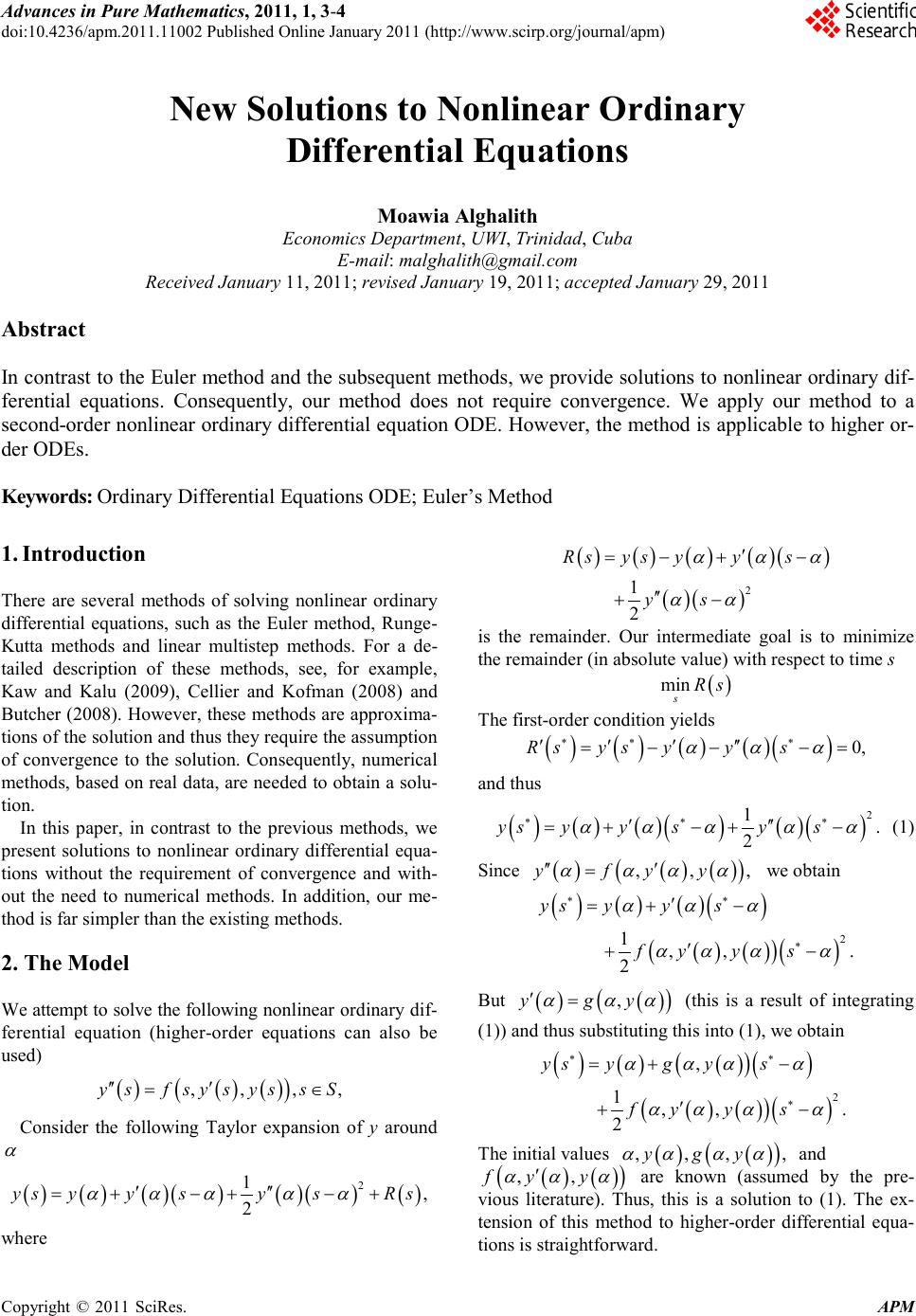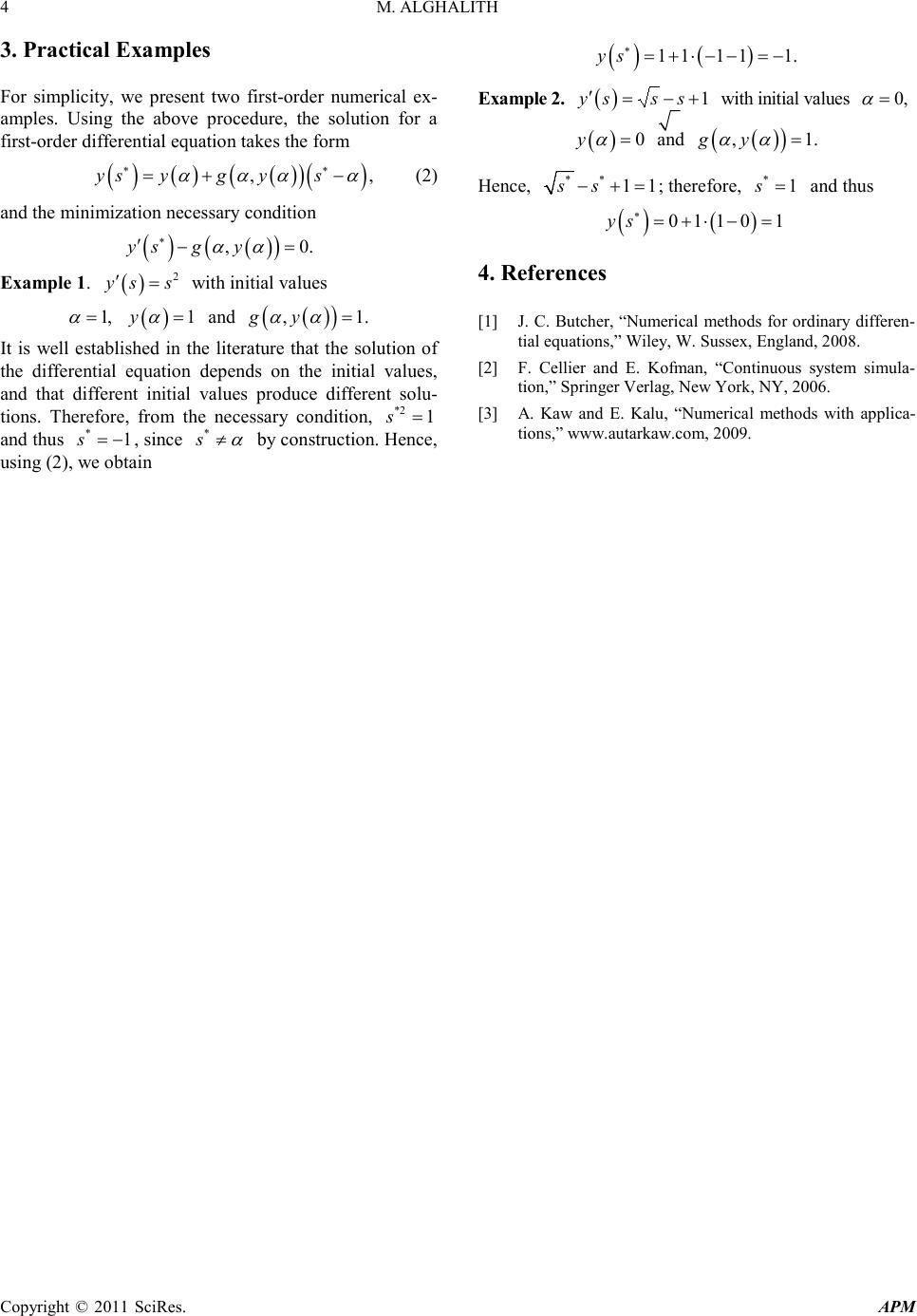Paper Menu >>
Journal Menu >>
 Advances in Pure Mathematics, 2011, 1, 3-4 doi:10.4236/apm.2011.11002 Published Online January 2011 (http://www.scirp.org/journal/apm) Copyright © 2011 SciRes. APM New Solutions to Nonlinear Ordinary Differential Equations Moawia Alghalith Economics Department, UWI, Trinidad, Cuba E-mail: malghalith@gmail.com Received January 11, 2011; revised January 19, 2011; accepted January 29, 2011 Abstract In contrast to the Euler method and the subsequent methods, we provide solutions to nonlinear ordinary dif- ferential equations. Consequently, our method does not require convergence. We apply our method to a second-order nonlinear ordinary differential equation ODE. However, the method is applicable to higher or- der ODEs. Keywords: Ordinary Differential Equations ODE; Euler ’s Method 1. Introduction There are several methods of solving nonlinear ordinary differential equations, such as the Euler method, Runge- Kutta methods and linear multistep methods. For a de- tailed description of these methods, see, for example, Kaw and Kalu (2009), Cellier and Kofman (2008) and Butcher (2008). However, these methods are approxima- tions of the so lution and t h us the y require the ass umptio n of convergence to the solution. Consequently, numerical methods, based on real data, are needed to obtain a solu- tion. In this paper, in contrast to the previous methods, we present solutions to nonlinear ordinary differential equa- tions without the requirement of convergence and with- out the need to numerical methods. In addition, our me- thod is far s imp ler t han the e xisti ng methods. 2. The Model We attempt to solve the following nonl inear or dinary dif- ferential equation (higher-order equations can also be used) ( )( )( ) ( ) , ,,,ysf sysyssS ′′ ′ = ∈ Consider the following Taylor expansion of y around α ()( )( )()( )()() 2 1, 2 ys yysysRs α αααα ′ ′′ =+−+− + where ( )( )()()() ( )() 2 1 2 Rsys yys ys α αα αα ′ =−+ − ′′ +− is the remainder. Our intermediate goal is to minimize the remainder (in abs olute value) with respect to ti me s ( ) min s Rs The first-order condition yields ( )( ) ( )( ) ( ) 0,Rsys yys ααα ∗∗ ∗ ′′′ ′′ =− −−= and thus ( ) ( )( ) ( ) ( ) ( ) 2 1. 2 ys yysys ααα αα ∗ ∗∗ ′ ′′ = +−+− (1) Since ( )( )( ) ( ) ,,,yfy y ααα α ′′ ′ = we obtain ( ) ( )( ) ( ) ( )( ) ( ) ( ) 2 1 ,,. 2 ys yys fy ys ααα αα αα ∗∗ ∗ ′ =+− ′ +− But ( )( ) ( ) ,y gy α αα ′= (this is a result of integrating (1)) and thus subst itut in g this into (1), we obtain ( ) ( )( ) ( ) ( ) ( )( ) ( ) ( ) 2 , 1 ,,. 2 ysygys fy ys α ααα αα αα ∗∗ ∗ =+− ′ +− The initial values ( )( ) ( ) , ,,,y gy αα αα and ( )( ) ( ) ,,fy y αα α ′ are known (assumed by the pre- vious literature). Thus, this is a solution to (1). The ex- tension of this method to higher-order differential equa- tions is straightforward.  M. ALGHALITH Copyright © 2011 SciRes. APM 4 3. Practical Examples For simplicity, we present two first-order numerical ex- amples. Using the above procedure, the solution for a first-order differential equation takes the form ( ) ( )( ) ( ) ( ) ,,ysyg ys α ααα ∗∗ =+− (2) and the minimization necessary condition ( ) ( ) ( ) , 0.ysgy αα ∗ ′−= Example 1. ( ) 2 ys s ′= with initial values 1, α = ( ) 1y α = and ( ) ( ) , 1.gy αα = It is well established in the literature that the solution of the differential equation depends on the initial values, and that different initial values produce different solu- tions. Therefore, from the necessary condition, *2 1s= and thu s * 1s= − , since * s α ≠ by construction. Hence, using (2), we obtain ( ) ( ) 1 11 11.ys ∗ = +⋅−−=− Example 2. ( ) 1yss s ′=−+ with in i tial values 0, α = ( ) 0y α = and ( ) ( ) , 1.gy αα = Hence, ** 11ss− += ; therefore , *1s= and thus ( ) ( ) 0110 1.ys ∗ = +⋅−= 4. Referen ces [1] J. C. Butcher, “Numerical methods for ordinary differen- tial equations,” Wiley, W. Sussex, England, 2008. [2] F. Cellier and E. Kofman, “Continuous system simula- tion,” Springer Verlag, New York, NY, 2006. [3] A. Kaw and E. Kalu, “Numerical methods with applica- tions,” www.autarkaw.com, 2009. |

